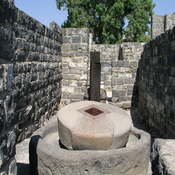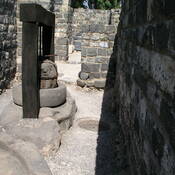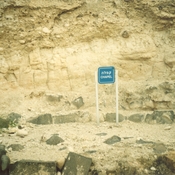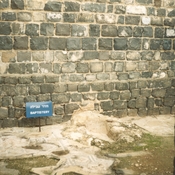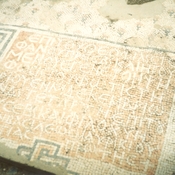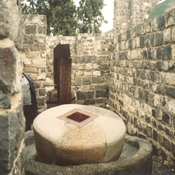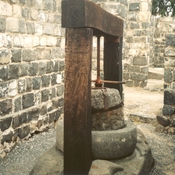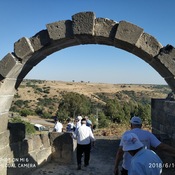Kursi is the Arabic name for the ruin on the eastern shores of the Sea of Galilee. During the mishnaic and talmudic periods this was a Jewish fishing village. The remains of Kursi were discovered accidentally after the 1967 Six Day War, when a road was paved along the eastern bank of the Sea of Galilee.
Excavations revealed the remnants of the largest Byzantine-period monastery in Israel (123 by 145 meters). The monastery and the church inside it were built in the middle of the fifth century C.E. and were apparently damaged during the Persian invasion (614 C.E.). The church was repaired but abandoned in the eighth century and never again used for prayer. In the church, archeologists found a mosaic floor with pictures of animals (chickens, geese, doves, cormorants, and fish), parts of which were vandalized, and pictures of plants such as citrons, dates, pomegranates, and grapes. The mosaic floor in the baptism room has a Greek inscription.
According to the New Testament, Jesus healed a man possessed by demons in Kursi. Mark relates that when Jesus disembarked from his boat, a "man with an evil spirit came from the tombs to meet him." A herd of swine was grazing in the area and Jesus cast the demonic spirits from the man to the swine. The swine then ran into the Sea of Galilee and drowned (Mark 5: 1-20 and with slight variations, Matthew 8:28-33 and Luke 8:26-39). Although the evangelistic stories do not mention the precise place where this miracle took place, Christian tradition has always held that it was Kursi.
In 1980, a small chapel was discovered with its apse built in a cave. Christian tradition ties this cave with the place the possessed man revealed himself to Jesus and where Jesus cleansed him with the help of the swine.
Lage:
- Israel, Kursi
- geo:32.825848,35.650261
- Lage ± 0-5 m.
Klassification:
- Bäuerliche Siedlung
- Sichtbar
Identifiers:
- vici:place=34992
Anmerkungen
Kursi is the Arabic name for the ruin on the eastern shores of the Sea of Galilee. During the mishnaic and talmudic periods this was a Jewish fishing village. The remains of Kursi were discovered accidentally after the 1967 Six Day War, when a road was paved along the eastern bank of the Sea of Galilee.
Excavations revealed the remnants of the largest Byzantine-period monastery in Israel (123 by 145 meters). The monastery and the church inside it were built in the middle of the fifth century C.E. and were apparently damaged during the Persian invasion (614 C.E.). The church was repaired but abandoned in the eighth century and never again used for prayer. In the church, archeologists found a mosaic floor with pictures of animals (chickens, geese, doves, cormorants, and fish), parts of which were vandalized, and pictures of plants such as citrons, dates, pomegranates, and grapes. The mosaic floor in the baptism room has a Greek inscription.
According to the New Testament, Jesus healed a man possessed by demons in Kursi. Mark relates that when Jesus disembarked from his boat, a "man with an evil spirit came from the tombs to meet him." A herd of swine was grazing in the area and Jesus cast the demonic spirits from the man to the swine. The swine then ran into the Sea of Galilee and drowned (Mark 5: 1-20 and with slight variations, Matthew 8:28-33 and Luke 8:26-39). Although the evangelistic stories do not mention the precise place where this miracle took place, Christian tradition has always held that it was Kursi.
In 1980, a small chapel was discovered with its apse built in a cave. Christian tradition ties this cave with the place the possessed man revealed himself to Jesus and where Jesus cleansed him with the help of the swine.
In der Nähe
Kursi, olive press
An ancient olive press found in the monastery buildings
Kursi (Golan Heights)
Ruins of a Byzantine Christian monastery 5th century.
Kursi (Golan Heights)- Olive Press
Ancient Olive Press.


